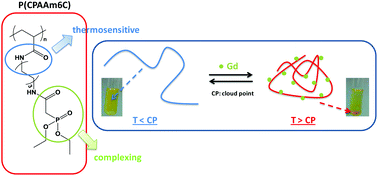The first report on phosphonate-based homopolymers combining both chelating and thermosensitive properties of gadolinium: synthesis and evaluation†
Abstract
An original phosphonate-based acrylamide was first prepared in four steps including the incorporation of a valuable carbamoylmethylphosphonate moiety. This monomer was then polymerized, thus leading to poly(diethyl-6-(acrylamido)hexylcarbamoylmethylphosphonate) (P(CPAAm6C)), combining both thermosensitivity and chelating properties. The influence of different parameters (polymer concentration, salt, and acidity) on the P(CPAAm6C) cloud point was determined, mainly considering the salting-out and salting-in effect related to the Hofmeister series. Finally, it was proved that thermosensitive P(CPAAm6C) was efficient for the complexation of gadolinium below and above the cloud point. The latter logically depended on the Gd sorption. To our knowledge, the P(CPAAm6C) polymer represents the only example reported in the literature where only one monomeric unit can allow, on the one hand, the complexation of rare earth elements, in particular gadolinium, and, on the other hand, thermo-responsive properties. The poly(diethyl-6-(acrylamido)hexylcarbamoylmethylphosphonate) polymers open the way to new materials that could be used for the treatment of rare earth elements containing effluents, allowing their recovery while possibly recycling the homopolymer.


 Please wait while we load your content...
Please wait while we load your content...